How to Make Your Home Wheelchair Accessible
A thoughtful home design can greatly increase the comfort and ease for a person in a wheelchair. With many new products and styles on the market today, it is possible to design a wheelchair accessible home that is not only functional but also visually appealing.
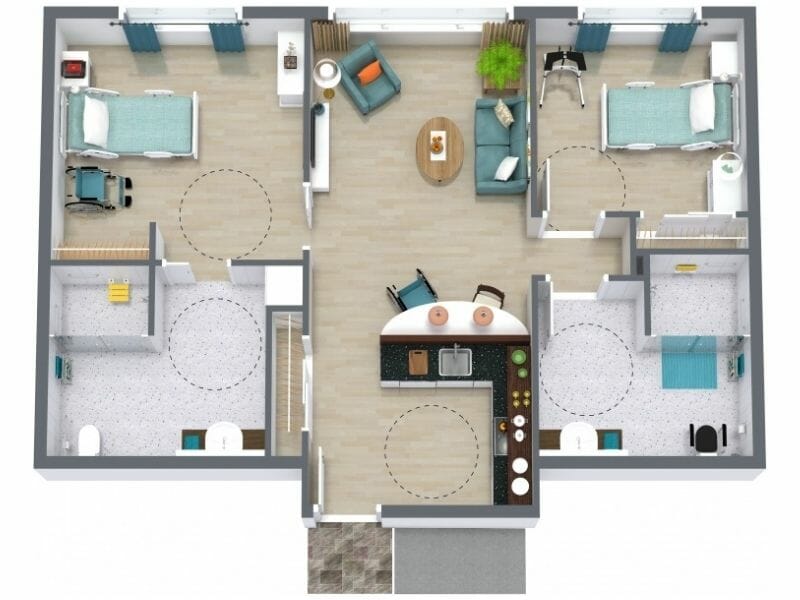
Accessible homes can be customized to people’s specific needs, but there are common modifications that appear in many remodels that are focused on wheelchair users. Let’s take a look at the ideas shown in this apartment, which was set up for a two-person family, one of whom uses a wheelchair and the other a walker.
Entryways, Doors, and Hallways
Entry. If the entrance is slightly elevated, consider adding an entrance ramp, shown at the bottom center of the floor plan below. As you enter through the door, it’s a good idea for the threshold to be very low or completely flush with the floor, for a smooth rolling experience.
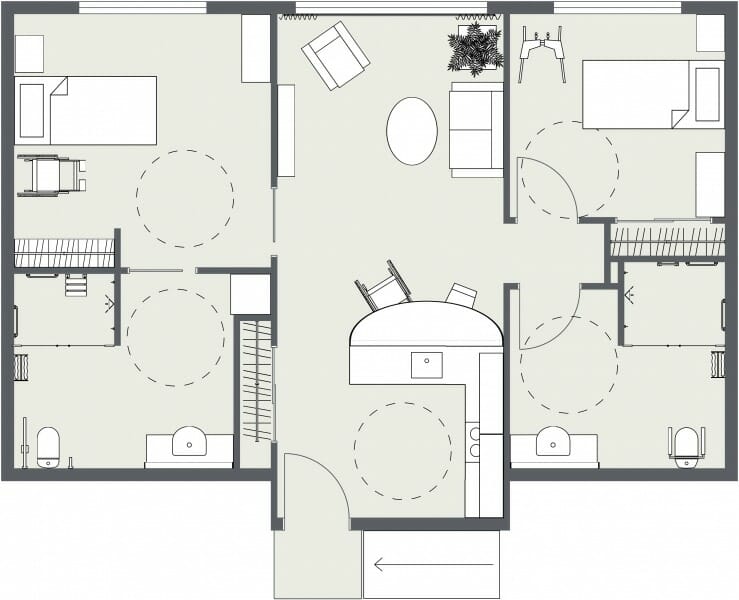
Doors and Hallways. As shown in the floor plan above, this unit has wide doors and hallways. If you want to ensure your home is wheelchair accessible, the minimum recommended door size is 32” (813 mm). If the person will be wheeling themself, it’s nice to provide extra space for their hands as they roll through a door. The entry door in the home shown above is a generous 42” (1067 mm) wide. The wheelchair-accessible bedroom on the left uses 40” (1016 mm) pocket doors, that can be left open if desired, or outfitted as automatic sliding doors. Standard swing doors in the unit are also approx 40” (1016 mm), to easily accommodate the other resident who uses a walker.
Turn-around space. Notice the circular wheelchair symbol on the floor plan above, which demonstrates the clearance needed to turn the wheelchair, generally 60” (1525 mm).
Kitchen/Dining
Appliances. This kitchen features under-counter appliances, which can be easier to reach for many users. Both the dishwasher and oven have controls that are placed on the front, for easy and safe access – reaching for a control knob over a still-hot burner is risky for someone who is seated in front of a stove. This unit also features an under-counter refrigerator/freezer, located on the right in the image below.

Cabinets. Kitchen storage is in pull out drawers, which allow more access to items stored towards the back. A lazy Susan installed inside the corner cabinet allows a user to rotate items into view. Upper storage is on a shelf that has been mounted at 15” (381 mm) above the counter, rather than the standard 18” (457 mm) to make it easier for a wheelchair user to access plates, bowls, and other items. Another option would be to install shelving lifts inside upper cabinets, which allow a seated user to safely lower the shelves and their contents.
Sink. An accessible sink is less deep than a regular sink, to make it easier to reach items. A single lever faucet makes for easier one-handed operation.
Electrical Outlets. Electrical outlets have been planned for accessibility. Notice the outlets on the side of the cabinet in the bottom left of the image above.
Dining. This apartment features a built-in dining counter. Because a wheelchair armrest is usually around 29”, it’s a good idea to plan the height of your dining table or counter to be slightly higher, so that the wheelchair can roll under.

In a nice touch, this dining counter’s round contours mean no one will accidentally bump into a sharp corner.
Living Room
The living room has a large window for plenty of natural light as well as reading lamps, helpful for anyone with low vision. Storage is low for access from a wheelchair. The rounded corners on the coffee table ensure that no one will bump a sharp corner.
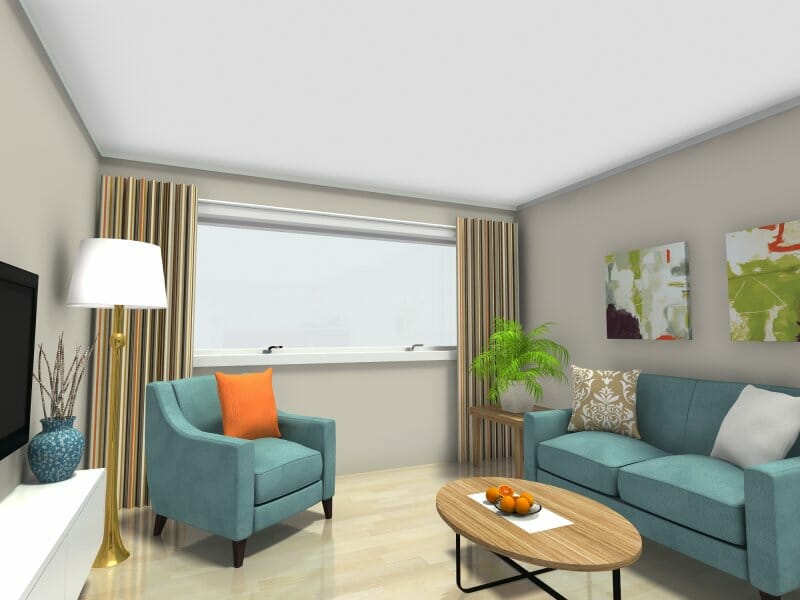
Wheelchair Accessible Bedroom
Bed. The bedroom features an electric bed that allows the user to sit up at any angle. A handy reading lamp mounted on the wall, along with books placed on the side table next to the bed, is a good idea for reading comfortably at night.
Closet. The closet for the wheelchair-accessible room does not have doors – this was a request to make it easier to access shoes, clothing, and other items. The closet rod has been placed at a lower level for easier access.
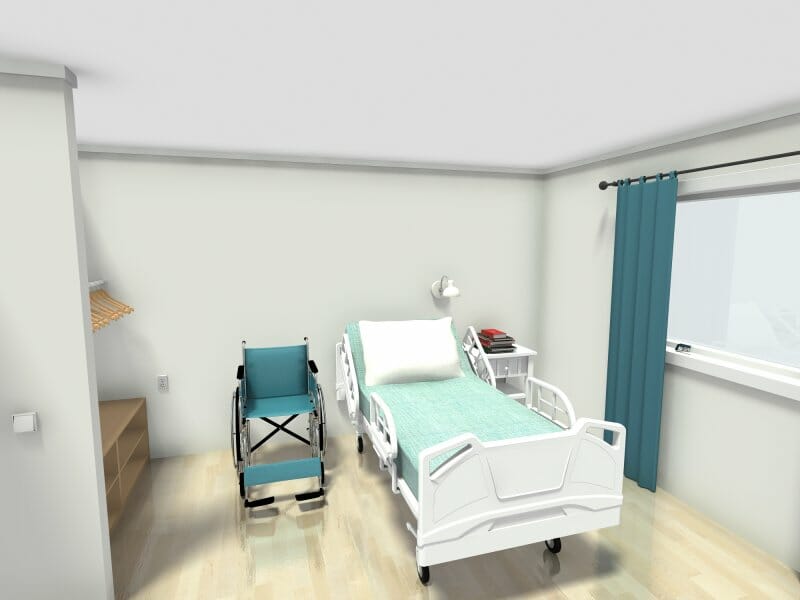
Lighting and Power. An easy-to-operate light switch is placed at an accessible height for a wheelchair user. Another idea is motion-sensitive lighting. This room also features a large window for natural light during the day. Power outlets can also be adjusted at different levels, sometimes higher, sometimes lower, depending on the need.
Floor. This bedroom does not use a throw rug near the bed as it can impede the floor of the wheelchair.
Bathroom
Sinks. Both bathrooms feature wheelchair accessible sinks. For the faucet, it is a good idea to use a single-lever or even a touchless faucet.
Storage. The mirror and medicine cabinet has been placed on the lower side for easier viewing and access from a wheelchair.
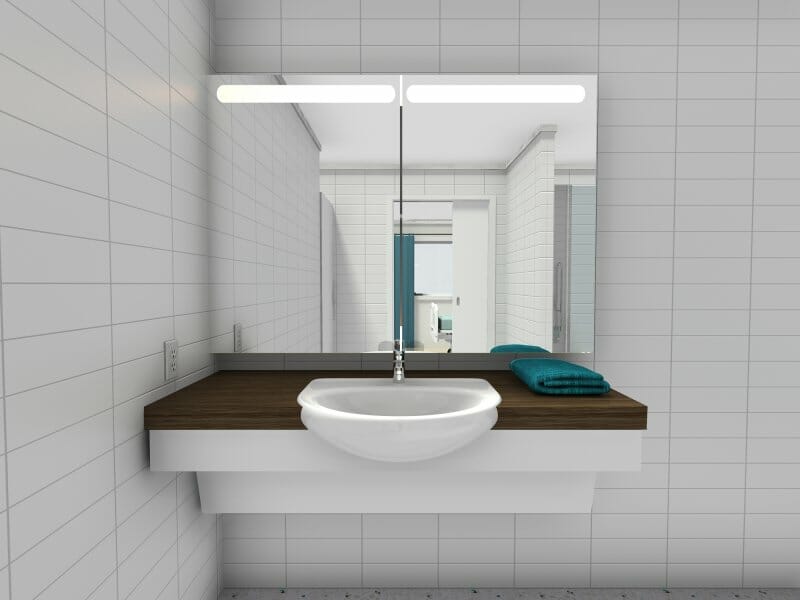
Electrical. The electrical plug is located on a side wall rather than the back wall so that it can be reached by someone who is seated. Another idea would be to locate electrical on the front or side of the bathroom vanity.
Toilet. Each toilet has grab bars for help with standing or sitting. The standard height of a toilet is approx 16” (406 mm) but a higher “comfort height” toilet can make it easier to transfer from a wheelchair and back again. Allow plenty of space next to the toilet for wheelchair transfers. Grab bars that can be rotated out of the way, as shown below, are a good idea.
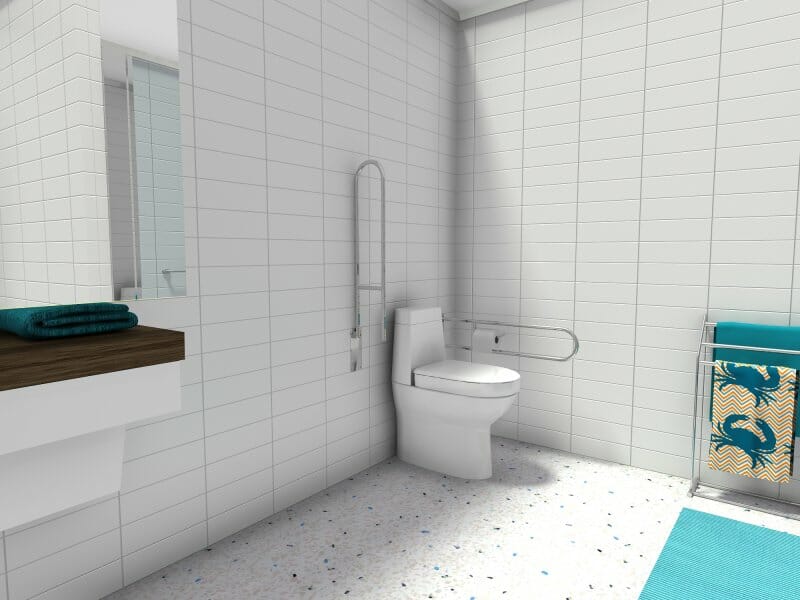
Shower. Each shower has a curb-less roll-in entry to allow a user to walk or roll into the shower. The floor is coated with a material to help avoid slips. Multiple grab bars are important for safe movement inside the shower. Walls should be reinforced where you will place the grab bars.

The hand-held shower unit allows a user to leave the shower on the wall, or unhook it and shower using the hose. The hose comes in various lengths to accommodate various needs and different size showers
Choose the Right Colors and Textures
Jacky Chou from Archute puts and emphasis on the importance of color and texture when designing a wheelchair accessible home:
"Color is one of the most powerful tools in interior design, as it can create different moods, atmospheres, and illusions. For a wheelchair-accessible home, you want to choose bright, cheerful, and inviting colors, as they can make the space feel more spacious and lively.
You can also use contrasting colors to highlight essential features like doorways, ramps, or grab bars. Textures are another way to add interest and variety to your design since they create a sense of warmth, coziness, and sophistication. You can use different fabrics, rugs, pillows, curtains, and wallpapers to create texture and depth in your space."
How to Design a Wheelchair Accessible Apartment
The floor plans and 3D Photos in this post were created with the RoomSketcher App. To see more images and views, open this complete Project Presentation. From there, you can also try out a 360 View of one of the rooms, and download the RoomSketcher App to edit the project.
With RoomSketcher, every user can access the RoomSketcher App and take snapshots for free, so you can start designing your wheelchair-accessible apartment straight away. Once your layout is ready, upgrade your RoomSketcher subscription for awesome 3D features such as – 3D Photos, 3D Floor Plans, and interactive Live 3D!
Don't forget to share this post!
Recommended Reads
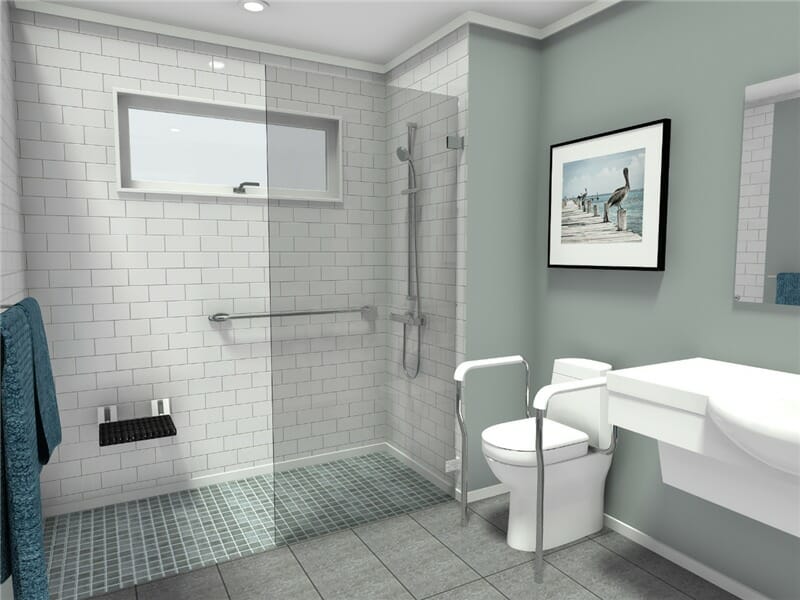
Design a Wheelchair Accessible Senior Bathroom
Here are some of the top steps to design a wheelchair accessible senior bathroom.
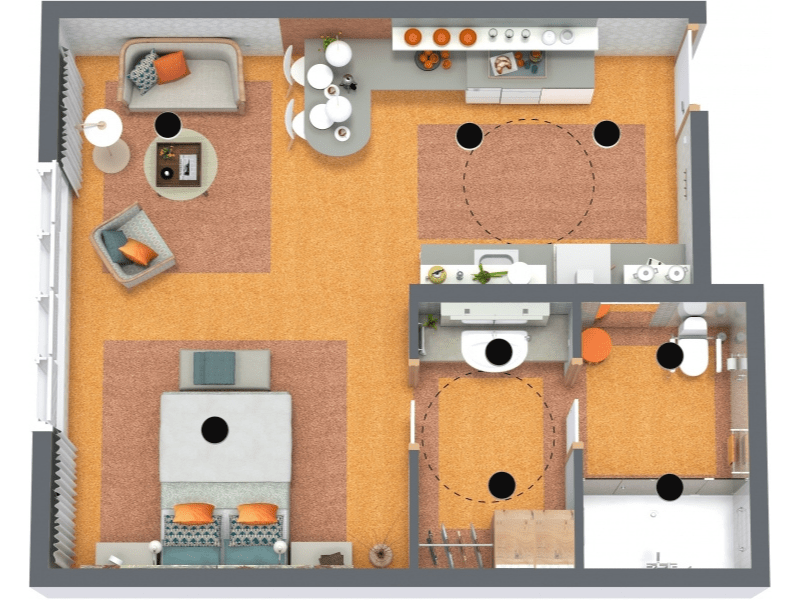
Apartment Floor Plan - Universal Design Ideas
Universal Design ideas that are easy to implement when designing your apartment. Lots of practical tips and inspiration. Learn more!
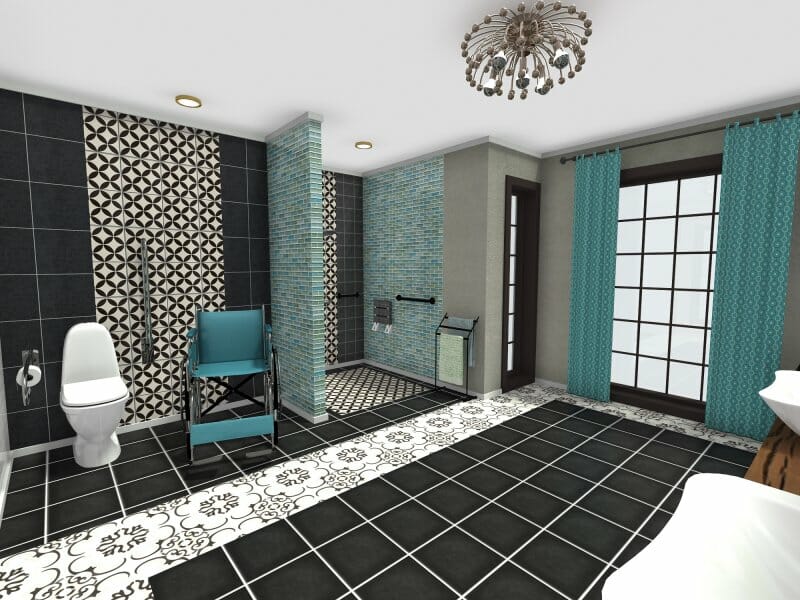
Bathroom Safety Tips for Seniors
Top safety tips to consider if you are remodeling a bathroom that will be used by a senior.